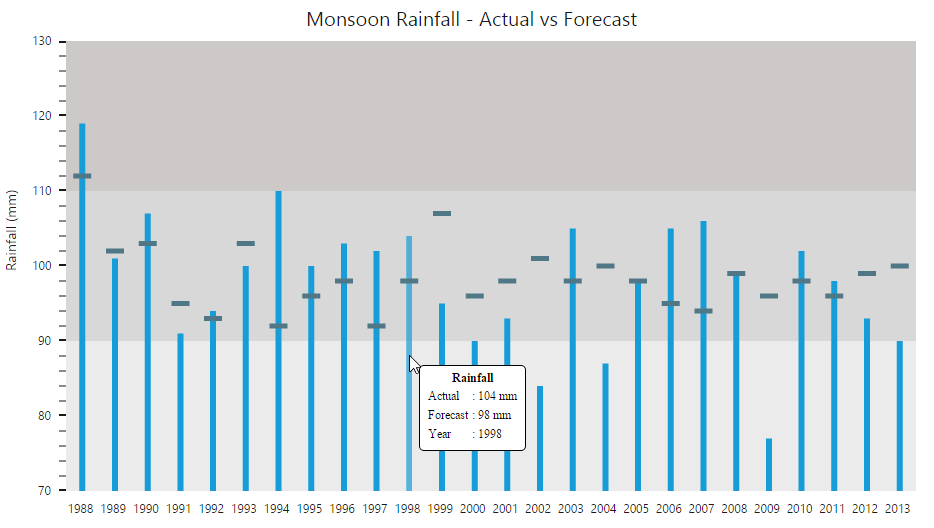Getting Started
4 Jan 201824 minutes to read
This section explains briefly about how to create a BulletGraph in your application with JavaScript.
Create your first BulletGraph in JavaScript
This section encompasses the details on how to configure the BulletGraph control in applications. It also helps you to learn how to pass the required data to it and to customize its various options according to their needs.
In the following screenshot, a BulletGraph is used to compare the actual monsoon rainfall received in a state versus its forecasted values for the years ranging from 1988 to 2013.
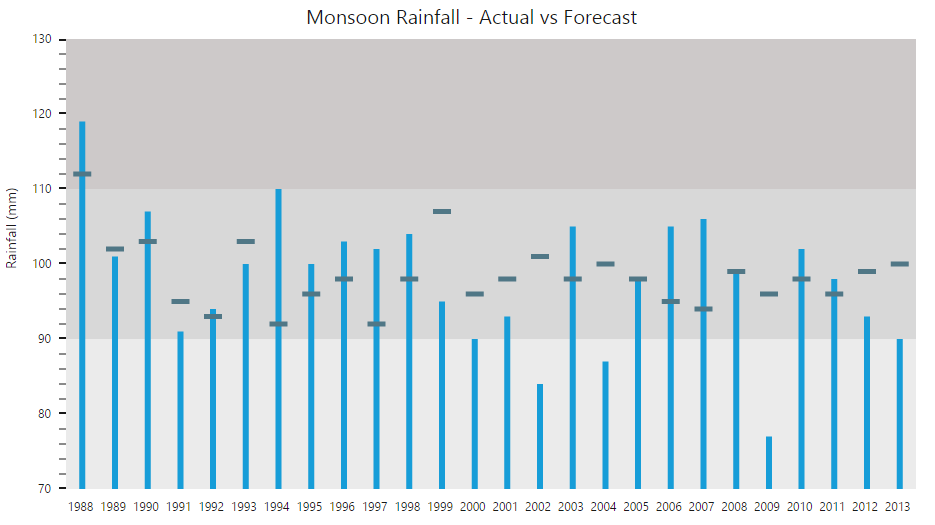
Create a BulletGraph
1.Create an HTML file and add references to the required libraries.
<!DOCTYPE html>
<html>
<head>
<!-- jquery script -->
<script src="http://cdn.syncfusion.com/js/assets/external/jquery-1.10.2.min.js"></script>
<!-- jquery localization dependency -->
<script src="http://ajax.aspnetcdn.com/ajax/globalize/0.1.1/globalize.min.js"></script>
<!-- Essential JS UI widget -->
<script src="http://cdn.syncfusion.com/28.1.33/js/web/ej.web.all.min.js"></script>
</head>
<body>
</body>
</html>2.Now add a <div> element that acts as a container for ejBulletGraph widget.
<html>
<body>
<div id="Bullet"></div>
</body>
</html>3.Once the container is added, create the ejBulletGraph widget as follows.
<head>
<!-- … -->
<script type="text/javascript">
$(function () {
$("#Bullet").ejBulletGraph();
});
</script>
</head>4.Run the above code and the BulletGraph is displayed. In order to customize the measure bars within the BulletGraph, either local or remote data should be passed to it.

Provide Required Data
You can customize the values of feature and comparative measure bars in a BulletGraph, either locally or remotely. The category data is optional, and is used to display label values in parallel to the measure bars.
Assign the data in localData variable to the dataSource property of BulletGraph as shown in the following code example.
var localData = [
{
value: 90, comparativeMeasureValue: 100,
category: 2013
},
{
value: 93, comparativeMeasureValue: 99,
category: 2012
},
{
value: 98, comparativeMeasureValue: 96,
category: 2011
},
{
value: 102, comparativeMeasureValue: 98,
category: 2010
},
{
value: 77, comparativeMeasureValue: 96,
category: 2009
},
{
value: 99, comparativeMeasureValue: 99,
category: 2008
},
{
value: 106, comparativeMeasureValue: 94,
category: 2007
},
{
value: 105, comparativeMeasureValue: 95,
category: 2006
},
{
value: 98, comparativeMeasureValue: 98,
category: 2005
},
{
value: 87, comparativeMeasureValue: 100,
category: 2004
},
{
value: 105, comparativeMeasureValue: 98,
category: 2003
},
{
value: 84, comparativeMeasureValue: 101,
category: 2002
},
{
value: 93, comparativeMeasureValue: 98,
category: 2001
},
{
value: 90, comparativeMeasureValue: 96,
category: 2000
},
{
value: 95, comparativeMeasureValue: 107,
category: 1999
},
{
value: 104, comparativeMeasureValue: 98,
category: 1998
},
{
value: 102, comparativeMeasureValue: 92,
category: 1997
},
{
value: 103, comparativeMeasureValue: 98,
category: 1996
},
{
value: 100, comparativeMeasureValue: 96,
category: 1995
},
{
value: 110, comparativeMeasureValue: 92,
category: 1994
},
{
value: 100, comparativeMeasureValue: 103,
category: 1993
},
{
value: 94, comparativeMeasureValue: 93,
category: 1992
},
{
value: 91, comparativeMeasureValue: 95,
category: 1991
},
{
value: 107, comparativeMeasureValue: 103,
category: 1990
},
{
value: 101, comparativeMeasureValue: 102,
category: 1989
},
{
value: 119, comparativeMeasureValue: 112,
category: 1988
}];
$(function () {
$("#Bullet").ejBulletGraph({
fields: {
dataSource: localData
}
});
});Once the dataSource property is assigned with the required values, you can bind the variable names used in the JSON data to the corresponding fields of the BulletGraph such as category, feature measures, comparative measure shown in below code example.
$(function () {
$("#Bullet").ejBulletGraph({
fields: {
dataSource: localData, category: "category",
featureMeasures: "value",
comparativeMeasure: "comparativeMeasureValue"
}
});
});Set Default and Scale Values
You can plot more number of measure bars within the BulletGraph, the height and width of the control should be increased to locate all the measure bars within the graph.The qualitative range size and quantitative scale length property needs to be set accordingly as shown in the following code example.
By default, the BulletGraph is rendered in the Horizontal orientation with its flow direction set to Forward. In this example,to achieve the desired output, horizontal orientation should be changed to Vertical orientation with the flow direction set to Backward.
Minimum, maximum and interval values for the quantitative scale of the bullet graph should be set, as shown in the following code example. The ticks and labels within the scale also need to be positioned.
$(function () {
$("#Bullet").ejBulletGraph({
width:850,
height: 540,
qualitativeRangeSize: 800,
quantitativeScaleLength: 425,
orientation: ej.datavisualization.BulletGraph.orientation.Vertical,
flowDirection: ej.datavisualization.BulletGraph.flowDirection.Backward,
quantitativeScaleSettings: {
minimum: 70,
maximum: 130,
interval: 10,
tickPosition: ej.datavisualization.BulletGraph.tickPosition.Above,
labelSettings: {
position: ej.datavisualization.BulletGraph.labelPosition.Above
}
},
fields: {
dataSource: localData, category: "category",
featureMeasures: "value",
comparativeMeasure: "comparativeMeasureValue"
}
});
});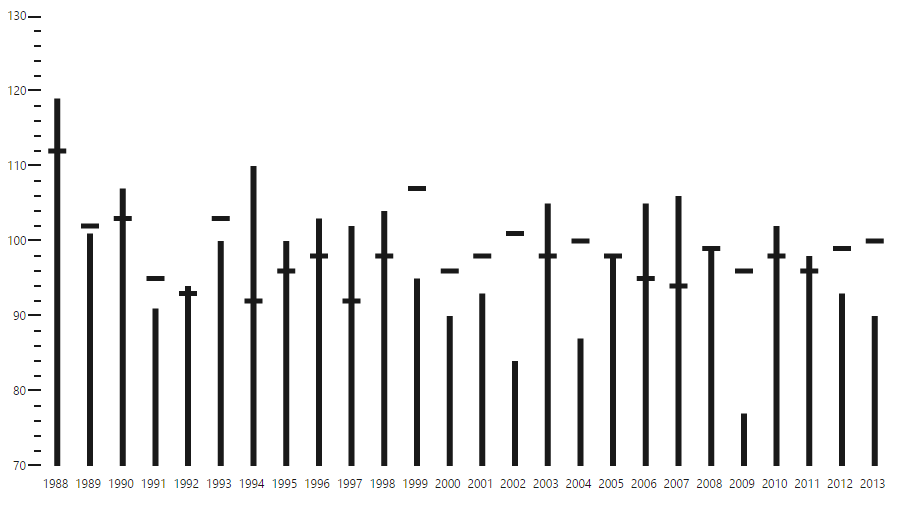
As you can see in the image above, the bullet graph without any ranges is displayed in the background. The steps to add the qualitativeRanges are described in the next section.
Add Qualitative Ranges
By default, 3 ranges are displayed in the BulletGraph control during the initial rendering of the control with its default values. In order to customize it, you need to set appropriate values for the range end,range opacity and its rangeStroke properties. Any number of qualitative ranges can be added to the control.
$(function () {
$("#Bullet").ejBulletGraph({
width:850,
height: 540,
qualitativeRangeSize: 800,
quantitativeScaleLength: 425,
orientation: ej.datavisualization.BulletGraph.orientation.Vertical,
flowDirection: ej.datavisualization.BulletGraph.flowDirection.Backward,
quantitativeScaleSettings: {
minimum: 70,
maximum: 130,
interval: 10,
tickPosition: ej.datavisualization.BulletGraph.tickPosition.Above,
labelSettings: {
position: ej.datavisualization.BulletGraph.labelPosition.Above
}
},
fields: {
dataSource: localData, category: "category",
featureMeasures: "value",
comparativeMeasure: "comparativeMeasureValue"
},
qualitativeRanges: [{
rangeEnd: 90
},
{
rangeEnd: 110
},
{
rangeEnd: 130, rangeStroke: "#CDC9C9"
}]
});
});After adding qualitativeRanges to the BulletGraph, the control will be rendered as follows.
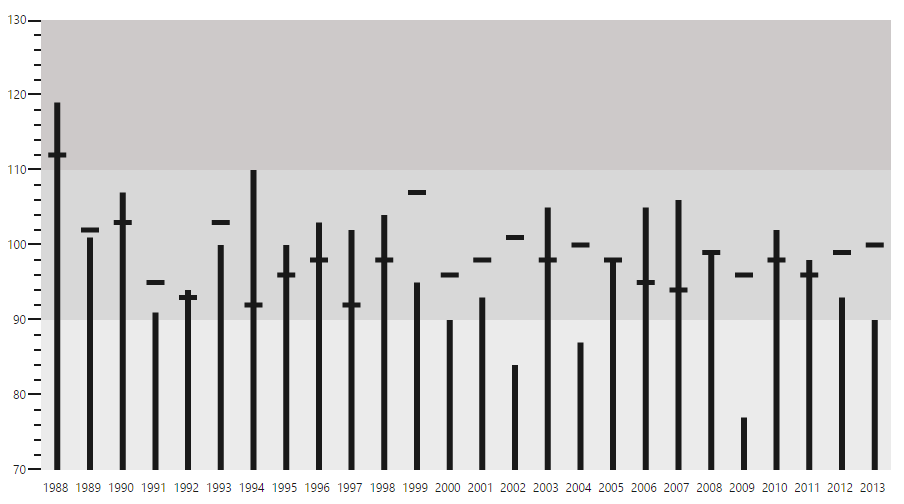
Ticks and Measure Bars Customization
You have to do the following code changes in the quantitative scale in order to customize the tick size, the colors of the feature bar and comparative measure symbols.
$(function () {
$("#Bullet").ejBulletGraph({
width:850,
height: 540,
qualitativeRangeSize: 800,
quantitativeScaleLength: 425,
orientation: ej.datavisualization.BulletGraph.orientation.Vertical,
flowDirection: ej.datavisualization.BulletGraph.flowDirection.Backward,
quantitativeScaleSettings: {
minimum: 70,
maximum: 130,
interval: 10,
tickPosition: ej.datavisualization.BulletGraph.tickPosition.Above,
labelSettings: {
position: ej.datavisualization.BulletGraph.labelPosition.Above
},
majorTickSettings:{width:1, size:7},
minorTickSettings:{width:1},
comparativeMeasureSettings:{stroke:"#507786"},
featuredMeasureSettings:{stroke: "#169DD8"},
},
fields: {
dataSource: localData, category: "category",
featureMeasures: "value",
comparativeMeasure: "comparativeMeasureValue"
},
qualitativeRanges: [{
rangeEnd: 90
}, {
rangeEnd: 110
}, {
rangeEnd: 130, rangeStroke: "#CDC9C9"
}]
});
});When customization of ticks and measure bars is done, BulletGraph looks as follows

Add Caption and Subtitle
You can display an appropriate Caption and Subtitle in the BulletGraph by adding the following code example.
$(function () {
$("#Bullet").ejBulletGraph({
width:850,
height: 540,
qualitativeRangeSize: 800,
quantitativeScaleLength: 425,
orientation: ej.datavisualization.BulletGraph.orientation.Vertical,
flowDirection: ej.datavisualization.BulletGraph.flowDirection.Backward,
quantitativeScaleSettings: {
minimum: 70,
maximum: 130,
interval: 10,
tickPosition: ej.datavisualization.BulletGraph.tickPosition.Above,
labelSettings: {
position: ej.datavisualization.BulletGraph.labelPosition.Above
},
majorTickSettings:{width:1, size:7},
minorTickSettings:{width:1},
comparativeMeasureSettings:{stroke:"#507786"},
featuredMeasureSettings:{stroke: "#169DD8"},
},
fields: {
dataSource: localData, category: "category",
featureMeasures: "value",
comparativeMeasure: "comparativeMeasureValue"
},
qualitativeRanges: [{
rangeEnd: 90
}, {
rangeEnd: 110
}, {
rangeEnd: 130, rangeStroke: "#CDC9C9"
}],
captionSettings: {
textAngle: 90,
location: { x: 470, y: 270 },
text: "Monsoon Rainfall - Actual vs Forecast",
font: { fontFamily: 'Segoe UI', size: '20px',
fontWeight: 'regular', opacity: 1 },
subTitle: {
textAngle: 0,
text: "Rainfall (mm)", location: { x: 180, y: 4 },
font: { fontFamily: 'Segoe UI', size: '14px',
fontWeight: 'regular', opacity: 1}
}
}
});
});The following screenshot displays a BulletGraph in the caption and title in the BulletGraph.
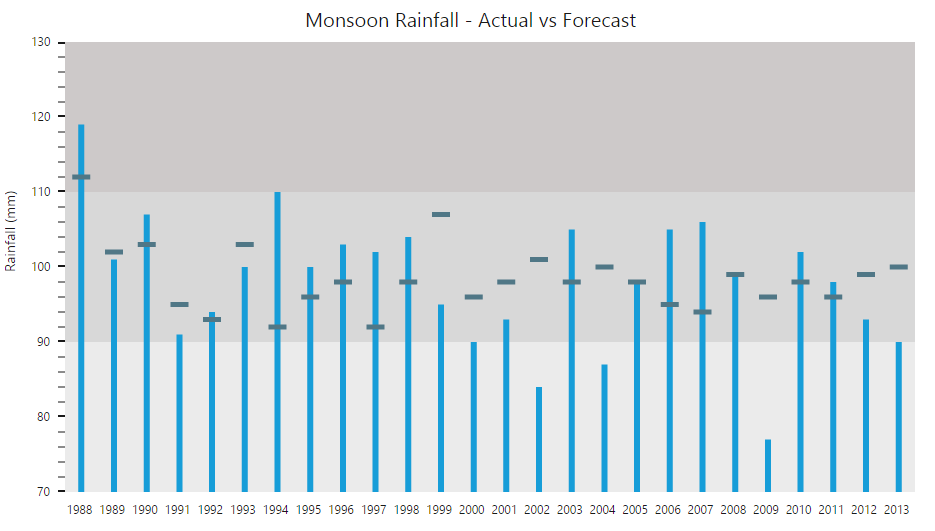
Show Tooltip
You can use a Tooltip in your application to display any information. In this example, a tooltip is used to show the values (in millimeter) of forecasted rainfall, actual rainfall received in (mm) and also the appropriate year. The tooltip is enabled by setting the visible property in tooltip to true. Also, in order to set the template tooltip, you can pass the template id to it as shown in the following code example.
$(function () {
$("#Bullet").ejBulletGraph({
width:850,
height: 540,
tooltipSettings:{visible:true, template: **: "Tooltip"**}
qualitativeRangeSize: 800,
quantitativeScaleLength: 425,
orientation: ej.datavisualization.BulletGraph.orientation.Vertical,
flowDirection: ej.datavisualization.BulletGraph.flowDirection.Backward,
quantitativeScaleSettings: {
minimum: 70,
maximum: 130,
interval: 10,
tickPosition: ej.datavisualization.BulletGraph.tickPosition.Above,
labelSettings: {
position: ej.datavisualization.BulletGraph.labelPosition.Above
},
majorTickSettings:{width:1, size:7},
minorTickSettings:{width:1},
comparativeMeasureSettings:{stroke:"#507786"},
featuredMeasureSettings:{stroke: "#169DD8"},
},
fields: {
dataSource: localData, category: "category",
featureMeasures: "value",
comparativeMeasure: "comparativeMeasureValue"
},
qualitativeRanges: [{
rangeEnd: 90
}, {
rangeEnd: 110
}, {
rangeEnd: 130, rangeStroke: "#CDC9C9"
}],
captionSettings: {
textAngle: 90,
location: { x: 470, y: 270 },
text: "Monsoon Rainfall - Actual vs Forecast",
font: { fontFamily: 'Segoe UI', size: '20px',
fontWeight: 'regular', opacity: 1 },
subTitle: {
textAngle: 0,
text: "Rainfall (mm)", location: { x: 180, y: 4 },
font: { fontFamily: 'Segoe UI', size: '14px',
fontWeight: 'regular', opacity: 1}
}
}
});
});Template content
<div id="Tooltip" style="display:none; width:125px;padding-top: 10px;padding-bottom:10px">
<div align="center" style="font-weight:bold">
Rainfall
</div>
<table>
<tr><td>Actual</td>
<td>: mm</td></tr>
<tr><td>Forecast</td>
<td>: mm</td></tr>
<tr><td>Year</td>
<td>: </td></tr>
</table>
</div>By using the customization options discussed in this section, the BulletGraph is rendered as displayed on the following screenshot.
